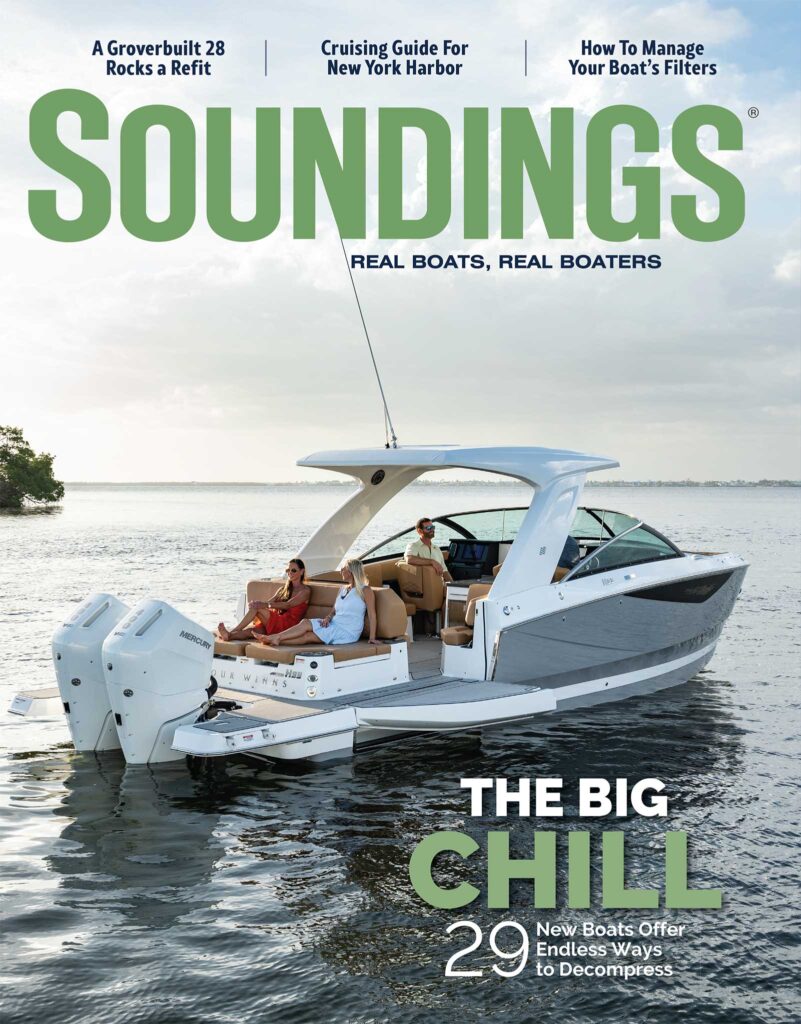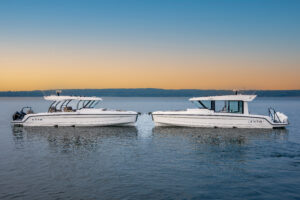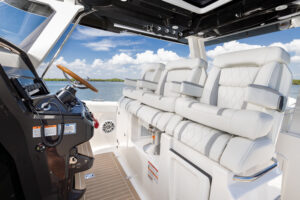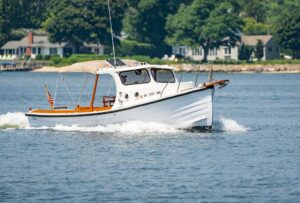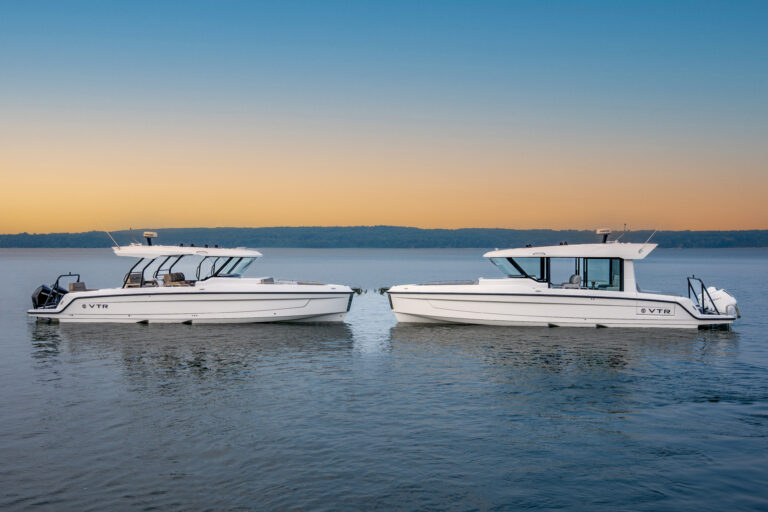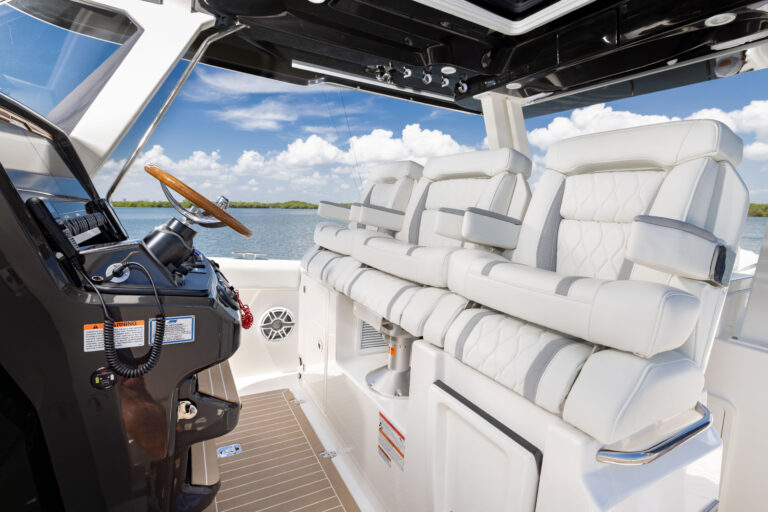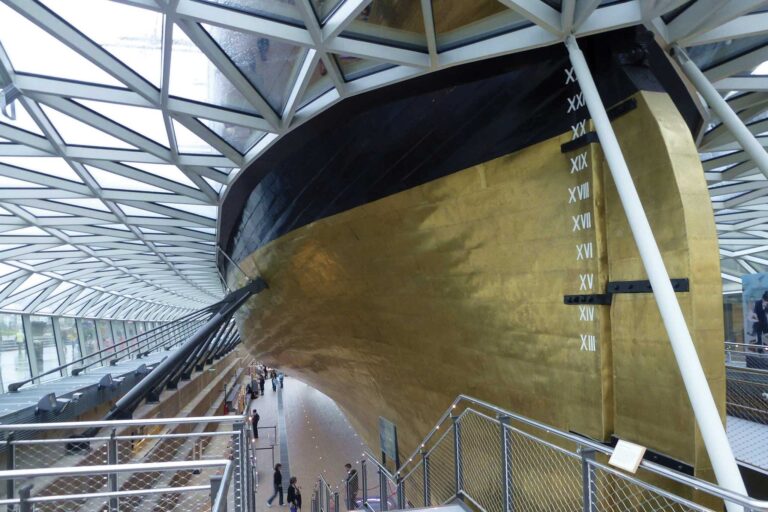Phin Sprague shares his insights on design and construction, formed by his experiences at sea

{loadposition position10}
What makes a good boat? Ask around at your marina and you’ll get many different answers, but you’ll also probably find general agreement in some areas. Nobody wants a power- or sailboat that’s likely to sink in a storm, and nobody wants one that’s likely to break apart in minutes if the skipper is foolish or unlucky enough to run it onto the rocks.
Late this summer, I visited Phineas Sprague, owner with his wife, Joanna, of Portland Yacht Services in Portland, Maine, a full-service boatyard and marina specializing in refits and restorations (www.portlandyacht.com). I asked him to share his insights on the subject. Phineas – or Phin, as he’s called – has circumnavigated in an old wooden schooner, has seen much in his travels that contributed to his opinions on what makes a good boat, and has worked on all kinds of power- and sailboats for decades. I figured he ought to know what he’s talking about. And he does.
The right fit
When I ask Phin, 61, just what makes a good boat (power or sail), he says without hesitation: “a boat that matches the resources and expectations of the owner. One that doesn’t put the owner in the poorhouse but that gives a lot of pleasure and causes very little pain.”
Part of the pain is the required maintenance that keeps a powerboat reliable and running for a long time. Too many people buy more boat than they can afford to maintain and operate and, consequently, they’re unhappy with the vessel. You have to be able and willing to do the maintenance or to pay a yard to do it, Phin says.
He says the idea that boats are overly complex can be the result of confusing cause and correlation. Here’s what he means. A boat with a lot of equipment sees more gear failures than a simpler craft and the many on-board systems are blamed. “Having a lot of problems and a lot of systems is a correlation, not a cause, and the cause is more likely to be a lack of maintenance or using cheap pumps, freezers or winches,” Phin says.

Phin uses Lions Whelp as an example. He and his brother, Abbot, bought the uncompleted hull of the 65-foot Alden-designed schooner back in 1998 and turned it into a practical cruising boat. They didn’t skimp on equipment, adding such luxuries as air conditioning, refrigeration, a stereo system, electronics and so on. “The secret was to install high-quality components where we could get to them for maintenance and to do the maintenance so they’d keep working. If it isn’t a burden, why not have it?” Phin notes.
On the other hand, Phin acknowledges that, for some people, simplicity is better. “Part of what makes a boat good is that it is perfectly suited to you and not necessarily to someone else. If you don’t want complexity, buy a simple boat,” he says.
When choosing a powerboat, it’s necessary to consider what might happen if essential systems fail, such as losing the main engine on a single-screw boat. “Asking yourself how much redundancy is built in is an important question and these questions take on more urgency the farther offshore you go,” Phin says.
Phin also points out that a good boat is one designed for how you intend to use it. If you want an offshore boat, you’ll put seaworthiness at the top of your priority list. If you want a boat for entertaining at the dock or in sheltered waters, you’ll probably focus on accommodations first. Builders make all kinds of claims about their boats in terms of ride, construction integrity and suitability of use, and the wise skipper should take them into account.
“A boat like a Carver or Silverton is fine for people who want a mobile home on the water, a roomy cocktail barge for use at the dock or in sheltered waters,” says Phin. “For some people, that [kind of] boat is perfect and I would recommend it to them. Just understand what it is and is not capable of.”
Heavy weather and your boat
In my conversation with Phin, I mention Tony Marchaj’s “Seaworthiness, the Forgotten Factor,” a superb reference source on the subject of seaworthiness. “That’s my Bible,” Phin says. It’s essential reading for anyone who wants a deeper understanding of the elements of seaworthiness, including dynamic stability, which is very often glossed over in favor of the more easily understood subject of static stability.
Static stability is the result of the force created at a given angle of heel by gravity pushing down at the vessel’s center of gravity and buoyancy pushing up at the hull’s offset center of buoyancy. This creates a rotational energy called a couple, created by these opposing, offset forces. Static stability exists even when the vessel is sitting at the dock, absolutely still.
Dynamic stability adds to the equation the inertia created by wind and wave, and the resulting motions of the hull. This is an important distinction because static stability is only a starting place when determining seaworthiness in a dynamic open-ocean environment. Heavy weights distributed too far forward and aft can create excessive pitching, reducing the boat’s controllability. And excessive sail area on a yacht with moderate GM – the distance from the center of gravity to the metacenter, a measure of initial stability – can nevertheless cause it to capsize in a 50-knot beam wind in just moderate seas. In other words, despite a seemingly healthy degree of static stability, these design flaws can create a dynamically unstable boat when encountering rough seas and strong winds.
While Phin uses sailing as a way to illustrate his views on seaworthiness, his perspective can also apply well to powerboats. When speaking of stability, he points to a typical 39-foot production sailboat, which might have a range of stability of 109 degrees. That would be pretty impressive for a planing powerboat, most of which would capsize at half that angle of heel, Phin says.
He goes on to explain that his Lions Whelp is stable through 145 degrees of roll: “The extra stability beam-to on the face of a breaking wave would mean the difference between loss of the vessel – and most likely everyone on it – and having to clean up a spilled [mug of] coffee in the cabin.” He adds that this is precisely why Marchaj’s emphasis on dynamic stability is so important, since it takes into consideration the stability-sapping inertia of wind and sea.
“When you get on the side of a wave, you get to 125 degrees in a hell of a hurry,” says Phin. “Lions Whelp’s positive righting arm to 145 degrees is there for a reason. This takes on new meaning if you’re on a wave gradient and at 125 degrees of roll the mast is still not wet.”
Seaworthiness refers to a boat’s ability to stay afloat and upright, so while our production 39-footer would be well-suited for operation in protected waters, Phin says he wouldn’t want to be aboard one in the open ocean 400 miles from land.
Moving on from stability issues, Phin says a boat’s maximum cruising speed is also a factor to consider in terms of the vessel’s seaworthiness. Ask yourself if your boat is fast enough to get away from an approaching storm system or if it is able to ride the storm out if caught in heavy weather. In either case, you need to know beforehand and take appropriate action, he says.
“The other thing is that people spend most of their time sailing along the coast in sheltered conditions,” says Phin. “Then when they get into heavy seas … they suddenly have a leak right over the electrical system, right when they’re least equipped to deal with it. They discover the leak when they’re 200 miles out and the seas are building.”
Keeping the inside of the boat dry is essential, not only for the ability of the crew to rest and function, but also because boats today are completely reliant on electrical systems to operate. Lose electricity and you may not be able to raise the sails, start the engine, call for help or even flush the head. You have to be able to keep the batteries charged, which means you need the engine or a generator. On Lions Whelp, Phin carries a portable engine starting-fluid injection system, Kold-Ban International’s NVT Porta Pack, which he can use to start the engine if his batteries fail.
“Marchaj has a great passage that I quote all the time,” says Phin. ” ‘The very essence of the human predicament is the split between reason and belief. The first is controlled by the rational mind; the second is governed by emotions and ideology. Belief tends to distort reality … via interpolation by frequently aggressive dominant minorities, into something acceptable to them. This is not to say that such people are self-consciously deceptive. They simply propagate belief, or rather perverted logic, which they may not themselves hold self-critically.’
“Now what this means is that it is the captain’s responsibility to diligently process cognitive data and intuitively grasp information as it comes in and look for an error in judgment,” Phin says. “Always assume an error has been made and act accordingly. Never rest. Never get complacent. Otherwise, the probability of accident and disaster increases exponentially. Failing to be questioning and perpetually diligent, a skeptic as to the safety of your vessel and crew, is like building the hull with a single skin. One bump and down she goes. There is nothing backing up that single fragile, penetrable skin – no redundancy, no Plan B or C and no time to come up with one.”
Phin continues: “Marchaj says seaworthiness is a function of the crew. When you think about it, a loss of seaworthiness is a cascading event and the crew has to be able to deal with the problem, whatever it is. Whatever the boat, it’s important that the captain understand its limitations. If the captain does not understand that, then he is not seaworthy and neither is his boat as seaworthy as it has the potential to be.”
Learning the ropes
The stage was set for Phin’s first prolonged offshore experiences at sea in 1972. He was just 22, and he and several partners bought a 1931 72-foot Alden-designed schooner christened High Tide. The boat had won so many races that it was eventually so heavily handicapped it could no longer win. Some 40 years later, in November 1973, Phin and his friends set sail in their new (to them, anyway) schooner, which they renamed Mariah.
They hit bad weather right away, cracking a few of the boat’s ribs in heavy seas, and had to pull into Florida for repairs before continuing on to the Panama Canal and the Pacific. While his partners soon became disenchanted with sailing an old, perpetually damp schooner and disembarked early on, Phin was in his element. If his forebears had managed months of deprivation at sea – did I mention Phin’s ancestors came to America on a ship named Lyon’s Whelp in 1629 – then certainly he could live the Spartan existence of his choosing for a few years. The circumnavigation continued and Phin didn’t return home until nearly four years later, having been joined in the meantime by his wife-to-be.
The only electronic navigation equipment on board was a Loran-A, which was quite useful for anyone within 200 miles of the U.S. coast, but not so useful offshore in the Pacific. Phin got to be proficient in not only the science and art of sailing, but also in celestial navigation. This, of course, was long before the advent of GPS.
As to his sailing companions, during the course of the voyage 56 people joined him on the adventure, flying halfway around the world to board the boat in some cases. “We found out that having lots of rules on board got to be ungainly,” he says. “Having lots of rules could only make a lawyer happy. So what we did when someone came on board was to sit them down and tell them that we expected everyone to act like a gentleman or a lady, and if they didn’t know how a gentleman or a lady should act in certain circumstances, [they should] just ask us.”
He continues: “When we sailed those long legs between Pacific islands with nothing but a compass and sextant, what I learned to do was to put my finger on the chart where I thought I was and then plot a fix. If the two positions were pretty close, then I knew my fix was probably correct. We learned a lot.”
The lessons accumulated from circumnavigating aboard Mariah planted the seeds for the design and construction 20 years later of Lions Whelp (see accompanying story). One experience that proved hard to forget was seeing other boats running aground, and rocks and coral reefs quickly having their way with a hull. “Over the years I’ve learned that when a boat goes aground, the ledge that it landed on chews its way right through the boat,” says Phin. “The weight of the boat makes the hull conform to the ledge and eventually the rock works its way through the planking. On Lions Whelp, the hull is 6 inches thick, including the Nida-Core, to guard against just such an emergency.”
Phin recalls an incident involving When and If, a 64-foot wooden schooner that went up on the rocks in Manchester-by-the-Sea, Mass., as a reason why he believes in thick hulls. He says the rock quickly ate its way through the schooner’s outer planking.
“A whole bunch of boats went up on the reef when we were in Tahiti,” Phin says. “The boats that were thrown across the reef we could rescue, but the ones that went up on the reef were destroyed. We saw a ferro-cement boat on the reef with a hole punched right through it and that hole actually kept the boat from moving along. … Eventually, there wasn’t a piece of that boat bigger than 5 feet long. It just shattered into pieces.”
After Phin and his fiancée completed their circumnavigation and returned to Maine – they wed during the voyage – they raised a family and built their boatyard and marina business in Portland. But the sea still held an irresistible allure, which is why Phin and his brother bought Lions Whelp and fitted the schooner out for long-distance cruising.
Like anything else worth doing in life, there are risks and rewards in boating. You can calculate risk on many levels. For example, if you’re close to a safe harbor when a storm approaches, you’re in a much less risky situation than if you are far out to sea in a boat that’s not designed for offshore use. Risk can even come down to the time of year and the nature of the waters where you go boating, and the experience, attitude and alertness of your crew. But with the right vessel designed for the kind of boating you do, the rewards are many and the risks reduced. The experiences make for memories you’ll carry for a lifetime, just like Phin did starting in earnest in 1973.
In the end, though, despite our best efforts, we just hope for the best. “We are all in God’s hands when we are out on the water,” Phin says. “The sea teaches a lot of lessons.” n
Eric Sorensen is a consultant to boat- and shipbuilders and to the government. He was founding director of the J.D. Power and Associates marine practice and is the author of “Sorensen’s Guide to Powerboats: How to Evaluate Design, Construction and Performance.” A longtime licensed captain, he can be reached at eric@sorensensguide.com.
This article originally appeared in the November 2010 issue.

